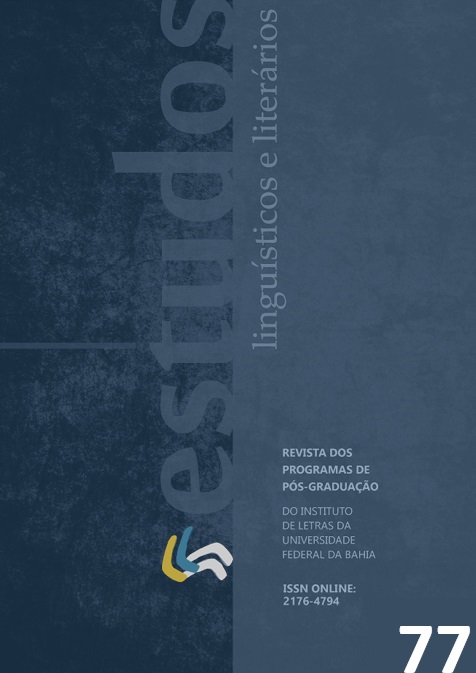EXCLUINDO CONSTRUÇÕES VSO E VOS EM PORTUGUÊS BRASILEIRO
Keywords:
Ordem de palavras; Sujeitos pós-verbais; Deslocamento de objeto; Movimento de verbo.Abstract
O português brasileiro não admite construções nas ordens verbo-sujeito-objeto e verbo-objeto-sujeito; enquanto sujeitos transitivos pós-verbais são excluídos, sujeitos pós-verbais apenas são produtivos com verbos inacusativos. Este artigo aborda a questão dos sujeitos pós-verbais e propõe uma análise formal da ausência de construções VSO e VOS em português brasileiro, que é derivada da combinação de duas propriedades da língua independentemente motivadas: (i) o domínio verbal é minimamente expandido para incluir uma posição de deslocamento de objeto na borda do vP e (ii) o verbo lexical se move para uma posição baixa no domínio de tempo e aspecto. Argumenta-se que a combinação destas duas propriedades do português brasileiro nos dá o resultado de que a área pós-verbal da língua é “pequena demais” para abrigar simultaneamente um sujeito e um objeto.
Downloads
References
ABELS, K. Successive cyclicity, antilocality, and adposition stranding. 2003. Doctoral thesis – University of Connecticut, Connecticut.
ARMELIN, P. Sentenças bitransitivas do português do Brasil revisitas à luz da teoria de núcleos funcionais aplicativos. 2011. Master’s thesis – Universidade de São Paulo, São Paulo.
AVELAR, J. O. de. Inversão locativa e sintaxe de concordância no português brasileiro. Matraga, v. 16, n. 24, p. 232-252, 2009.
AVELAR, J. O. de; CYRINO, S. Locativos preposicionados em posição de sujeito: Uma possível contribuição das línguas Bantu à sintaxe do português brasileiro. Revista de Estudos Linguísticos da Universidade do Porto, v. 3, p. 55-75, 2008.
BELLETTI, A. Aspects of the low IP area. In: RIZZI, L. (Ed.). The structure of CP and IP: The cartography of syntactic structures. V. 2. New York: Oxford University Press, 2004. p. 16-51.
BOŠKOVIĆ, Ž. On the timing of labeling: Deducing Comp-trace effects, the subject condition, the adjunct condition, and tucking in from labeling. The Linguistic Review, v. 33, p. 17-66, 2016.
BRITO, A. M. Clause structure, subject positions and verb movement: About the position of sempre in European Portuguese and Brazilian Portuguese. In: D’HULST Y.; ROORYCK, J.; Schroten, J. (Eds.). Romance Languages and Linguistic Theory 1999. Amsterdam: John Benjamins, 2001. p. 63-85.
CÉPEDA, P.; CYRINO, S. Putting objects in order: Asymmetrical relations in Spanish and Portuguese ditransitives. In: PINEDA, A.; MATEU, J. (Eds.). Dative Constructions in Romance and Beyond. Berlin: Language Science Press, 2020. p. 97-116.
CHOMSKY, N. Problems of projection. Lingua, v. 130, p. 33-49, 2013.
_____. Minimalist inquiries: The framework. In: MARTIN, R.; MICHAELS, D.; URIAGEREKA, J. (Eds.). Step by Step: Essays on Minimalist Syntax in Honor of Howard Lasnik. Cambridge, MA: MIT Press, 2000. p. 89-155.
_____. A minimalist program for linguistic theory. In: HALE, K.; KEYSER, S. J. (Ed.). The View from Building 20: Essays in Linguistics in Honor of Sylvain Bromberger. Cambridge, MA: MIT Press, 1993, p. 1-52.
CYRINO, S. On richness of tense and verb movement in Brazilian Portuguese. In: CAMACHO-TABOADA, V.; JIMÉNEZ-FERNÁNDEZ, Á. L.; MARTÍN-GONZÁLEZ, J.; REYES-TEJEDOR, M. (Eds.). Information Structure and Agreement. Amsterdam: John Benjamins, 2013. p. 297-317.
GROHMANN, K. Prolific Domains: On the antilocality of movement dependencies. Amsterdam: John Benjamins, 2003.
KATO, M. A. Deriving wh- in-situ through movement in Brazilian Portuguese. In: CAMACHO-TABOADA, V.; JIMÉNEZ-FERNÁNDEZ, Á. L.; MARTÍN-GONZÁLEZ, J.; REYES-TEJEDOR, M. (Eds.). Information Structure and Agreement. Amsterdam: John Benjamins, 2013. p. 175-192.
_____. A restrição de mono-argumentalidade da ordem VS no português do Brasil. Fórum Linguístico, v. 2, p. 97-127, 2000.
KATO, M. A.; TARALLO, F. Restrictive VS syntax in Brazilian Portuguese: Its correlation with invisible clitics and visible subjects. Paper presented at Georgetown Round Table in Languages and Linguistics, 1988.
LACERDA, R. On the absence of low focus movement in Brazilian Portuguese. Natural Language & Linguistic Theory, v. 42, p. 209-245, 2024.
_____. The middle field of Brazilian Portuguese and the size of the verbal domain. In: LASZAKOVITS, S.; SHEN, Z. (Eds.). The Size of Things I: Structure Building. Berlin: Language Science Press, 2021. p. 285-304.
_____. Middle-field syntax and information structure in Brazilian Portuguese. 2020. Doctoral dissertation – University of Connecticut.
_____. Rebel without a Case: Quantifier floating in Brazilian Portuguese and Spanish. In: KATO, M. A.; ORDÓÑEZ, F. (Eds.). Morphosyntax of Portuguese and Spanish in Latin America. New York: Oxford University Press, 2016. p. 78-106.
_____. Quantificadores flutuantes no português brasileiro. 2012. Master’s thesis – Universidade de São Paulo.
MIOTO, C. Focalização e quantificação. Revista Letras, v. 61, p. 169-189, 2003.
NUNES, J. Clíticos acusativos de terceira pessoa em PB como concordância de objeto. In: GALVES, C.; KATO, M. A.; ROBERTS, I. (Eds.). Português Brasileiro: Uma segunda viagem diacrônica. Campinas: Editora da UNICAMP, 2019. p. 151-172.
_____. De clítico a concordância: O caso dos acusativos de terceira pessoa em português brasileiro. Cadernos de Estudos Linguísticos, v. 57, p. 61-84, 2015.
QUAREZEMIN, S. Estratégias de focalização no português brasileiro: Uma abordagem cartográfica. 2009. Doctoral thesis – Universidade Federal de Santa Catarina, Florianópolis.
SPORTICHE, D. A theory of floating quantifiers and its corollaries for constituent structure. Linguistic Inquiry, v. 19, n. 2, p. 425-451, 1988.
TESCARI NETO, A. 2013. On verb movement in Brazilian Portuguese: A cartographic study. 2013. Doctoral thesis – Università Ca’ Foscari di Venezia.


